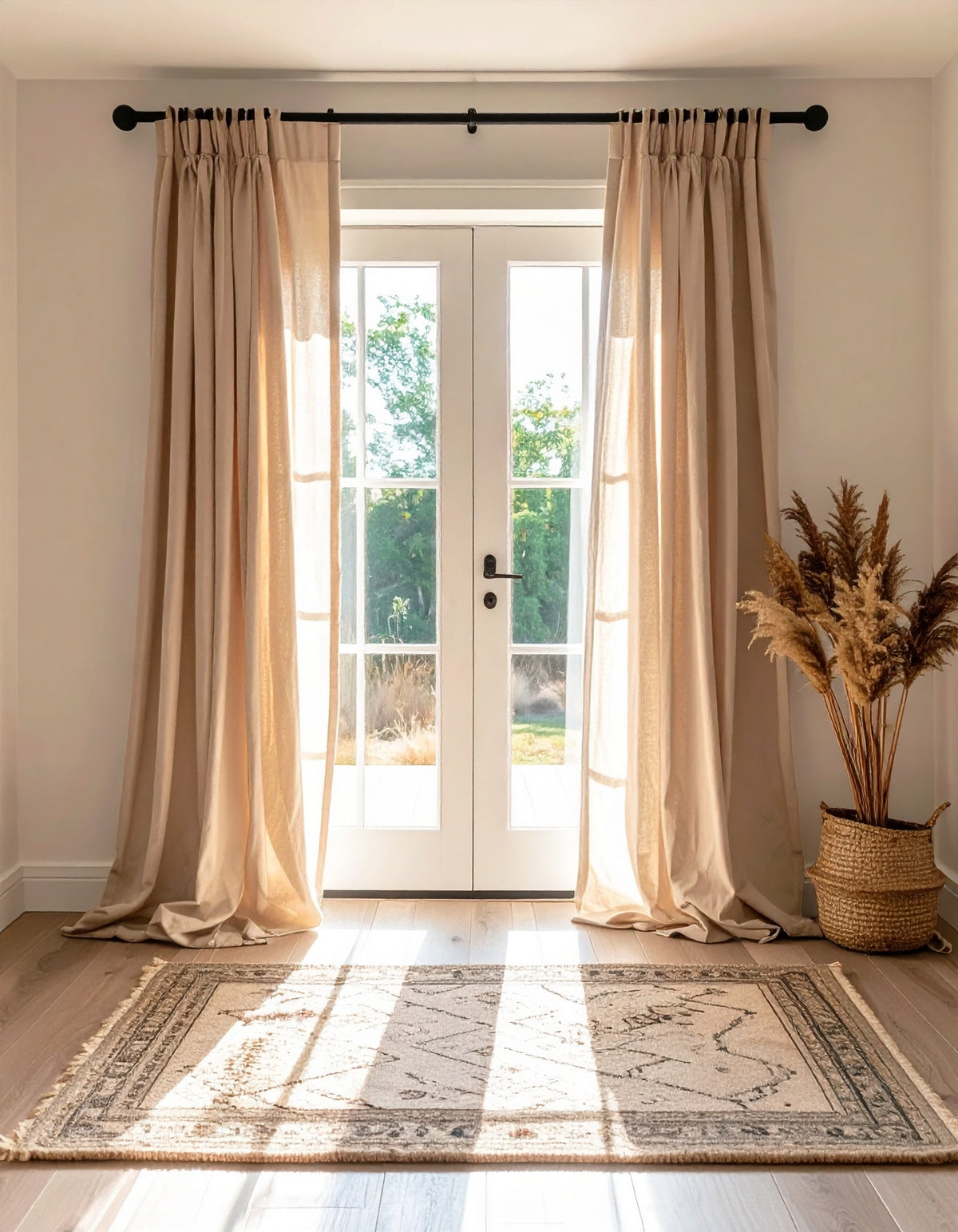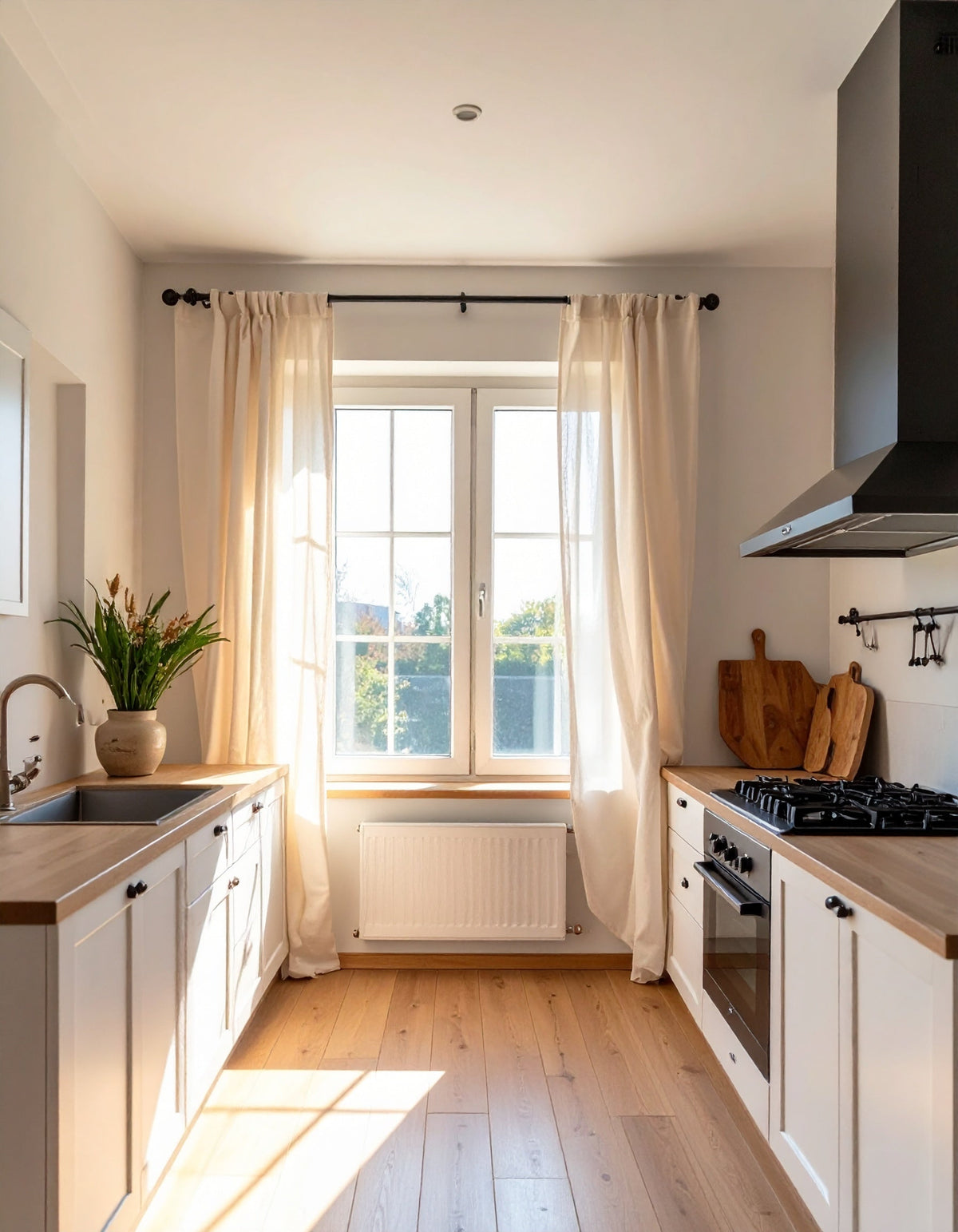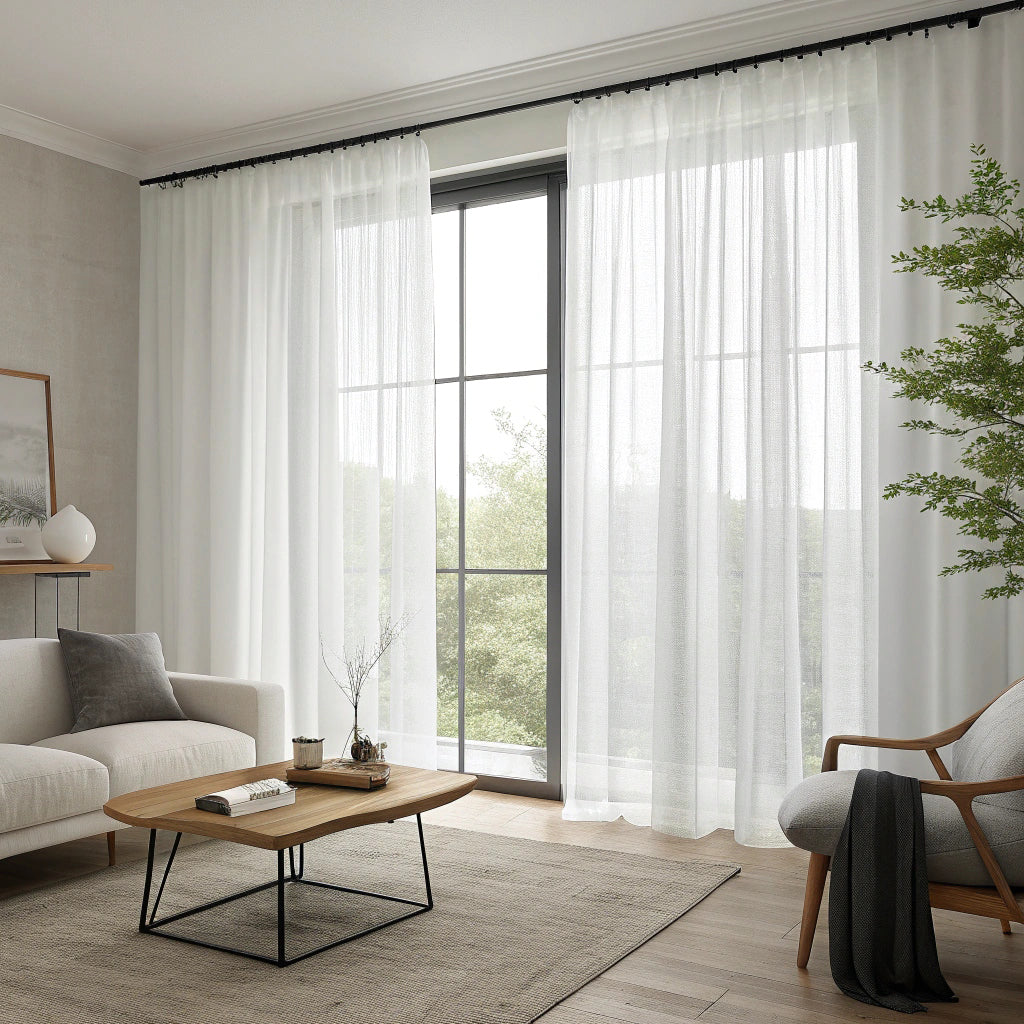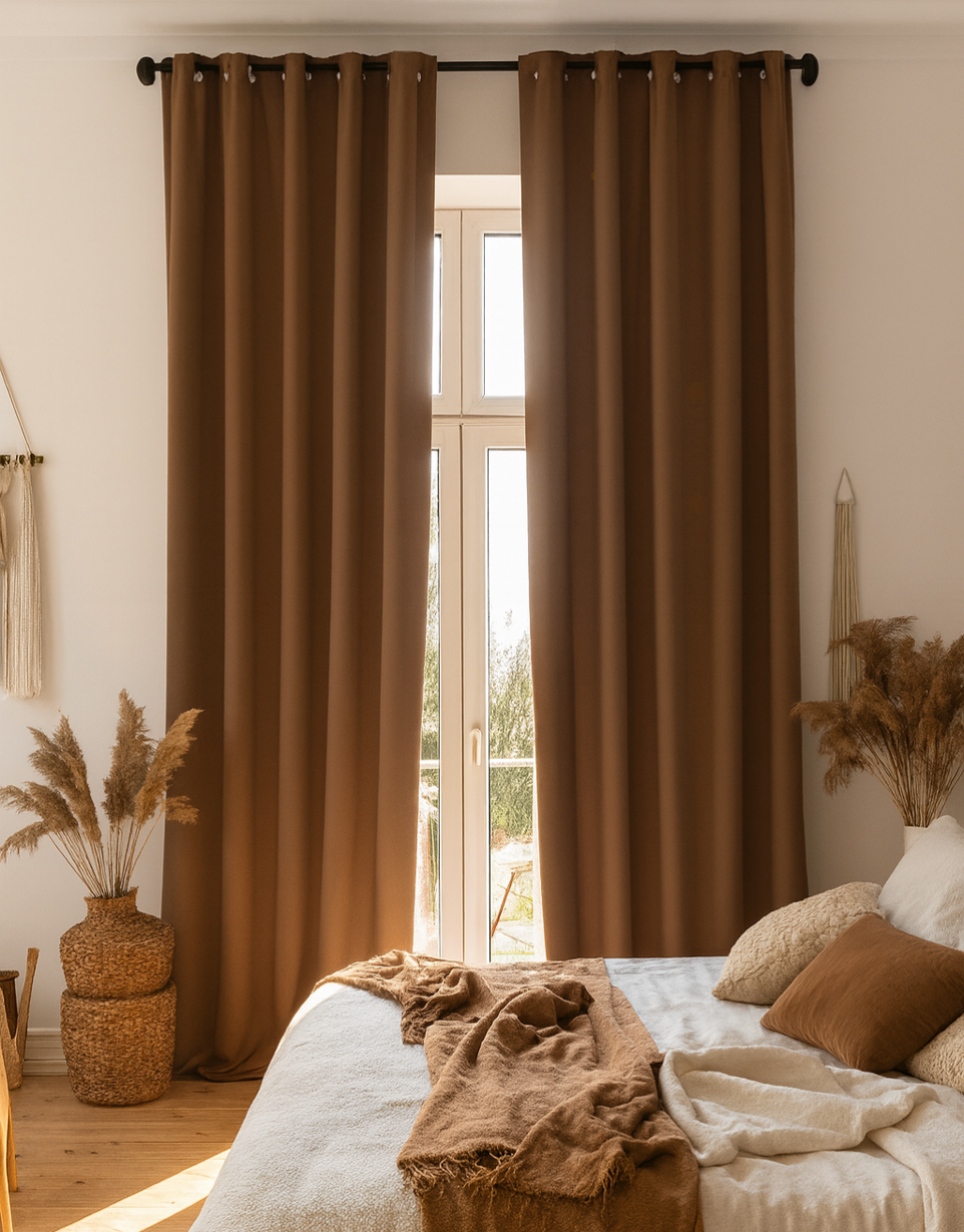FAQs
Start by thinking about what you want your curtains to do for the space. Do you mainly want privacy? Light control? Or are you more focused on the look and feel? For bedrooms, many people go with blackout or lined curtains so the room stays dark and cozy for sleeping. Living rooms often look beautiful with semi-sheers or lighter fabrics that let natural light filter through while still giving some privacy. If you want your curtains to make a design statement, don’t be afraid to choose a bold color or textured fabric that contrasts with your walls. And don’t forget the practical side. Rooms with lots of sun may benefit from lined curtains to prevent fading, while humid rooms like kitchens do better with easy-care fabrics.
Yes, we do! We offer free fabric swatches so you can see and feel the fabric before committing.
No, curtains don’t come with those accessories. The idea is that everyone’s setup is a little different. Some people already have rods, others have a track system, and many want to choose their own style of rings or hooks to match their décor.
The header is the top part of the curtain, and it really affects how the fabric hangs. We offer a wide variety:
Grommet: Metal rings at the top that slide directly onto a rod. Modern and easy to move.
Back tab: Hidden loops at the back for a neat, tailored look.
Rod pocket: The rod slips through a sewn pocket. Classic and casual, though less easy to slide.
Tab top: Fabric loops on top. Laid-back and informal.
Pinch pleat (double or triple): Folds sewn in at the top for a structured look.
Euro pleat (double or triple): Similar to pinch pleat, but the pleats are tacked at the very top for a more contemporary style.
Ripple fold: Works with a special track to create consistent, flowing waves.
Flat panel: Simple and versatile, often used when you want a very minimal look.
Grommet: Metal rings at the top that slide directly onto a rod. Modern and easy to move.
Back tab: Hidden loops at the back for a neat, tailored look.
Rod pocket: The rod slips through a sewn pocket. Classic and casual, though less easy to slide.
Tab top: Fabric loops on top. Laid-back and informal.
Pinch pleat (double or triple): Folds sewn in at the top for a structured look.
Euro pleat (double or triple): Similar to pinch pleat, but the pleats are tacked at the very top for a more contemporary style.
Ripple fold: Works with a special track to create consistent, flowing waves.
Flat panel: Simple and versatile, often used when you want a very minimal look.
First, look at the hardware you already have. If it’s a standard decorative rod, grommets, rod pockets or back tabs will slide right on. If you’re using rings, pinch pleat or euro pleat curtains are the easiest choice since they come with spaces for hooks or pins. If you have a ceiling or wall-mounted track system, go with pinch pleats or ripple fold headers. They’re designed to glide smoothly along tracks. If you’re starting fresh and haven’t bought rods yet, you can pick the curtain style you love first and then choose hardware to match.
Yes, but it depends on the material. Light fabrics like cotton and polyester are usually machine washable. Just use a delicate cycle with cold water and mild detergent. Heavier fabrics, silks, velvets or curtains with linings often need dry cleaning. Between washes, steaming and regular dusting with a vacuum’s fabric attachment helps keep them fresh.
Yes, both work. Ironing on a low setting is fine for cotton or polyester, but avoid ironing delicate fabrics directly. Steaming is often easier since you can do it with the curtains hanging. It relaxes wrinkles and freshens the fabric without much effort.
It depends on the fabric, but here are some general tips: lighter cottons and polyesters can often be machine-washed on a gentle cycle. Always use cold water to prevent shrinking and let them air dry or tumble on low. Heavier fabrics like velvet, silk or curtains with special linings should usually be dry cleaned to keep their shape. In between washes, you can give your curtains a refresh with a steamer. Vacuuming with a soft brush attachment every few weeks also helps keep dust away, especially for curtains in high-traffic rooms.
Yes. Pleated styles like pinch pleat or euro pleat need more fabric than flat panel curtains because the folds are sewn into place. This extra fabric creates the structured look but also means that when the curtain is closed, it won’t look skimpy or stretched thin. As a rule of thumb, pleated curtains should be about 2–2.5 times the width of your window for nice fullness.
Yes, every curtain is made to the exact measurements you provide. You just enter your desired width and length on the product page, and we make them to fit your window perfectly.
We offer several:
Unlined: Light and airy, great if you want natural sunlight.
White lining: Adds a clean backing, protects the fabric and softens light.
Cotton lining: A step up in thickness, good for everyday use.
Triple weave lining: Heavier, helps with light filtering and insulation.
Blackout lining: Blocks nearly all light. Perfect for bedrooms or media rooms.
Black lining: A stylish option if you want a darker finish.
Unlined: Light and airy, great if you want natural sunlight.
White lining: Adds a clean backing, protects the fabric and softens light.
Cotton lining: A step up in thickness, good for everyday use.
Triple weave lining: Heavier, helps with light filtering and insulation.
Blackout lining: Blocks nearly all light. Perfect for bedrooms or media rooms.
Black lining: A stylish option if you want a darker finish.
Yes! Each panel comes with the option of a free tieback made from the same fabric. Every panel includes one tieback and a small button to attach it to the wall.
No, they come unlined unless you choose a lining option. This way, you can decide what works best for your space and how much light or privacy you want.
Lined curtains tend to drape better and feel more luxurious because the extra layer gives them body. They also last longer since the lining protects the fabric from fading in sunlight. Another big benefit is insulation: lined curtains help keep rooms cooler in summer and warmer in winter, which can reduce energy costs. If you want total darkness, like in a bedroom, lining, especially blackout, is the way to go.
Usually, two panels (one on each side) is enough for a standard window. For larger windows or if you like a fuller, more gathered look, add more panels. The important thing is to make sure the total width of all your panels combined is at least 1.5 to 2.5 times the width of your window. That’s what gives curtains that nice, full drape rather than looking stretched tight when closed.
Although you have the option to add lining also to sheer curtains, it’s generally not recommended to do so. Sheers are meant to be lightweight and airy and adding a lining makes them heavier and less translucent, which defeats the point. If you want both privacy and a sheer look, the best approach is layering: hang sheer curtains in front and add a lined curtain or blackout panel behind them.
The number of rings depends on your header type. For pleated styles, you’ll need one ring per pleat, plus one for each end. For example, a standard panel might need 8–12 rings. The goal is even spacing so the fabric hangs properly and doesn’t sag between rings.
No, rings aren’t included. Since rods and track systems vary, we leave ring choice up to you.
Yes, we cover the whole range.
Yes, absolutely. Pinch pleat headers are perfect for track systems. Ripple fold is another option if your track is designed for it.
Layering gives you the best of both worlds in terms of function and style. A common approach is to use roller shades or blinds for privacy and light control, then add curtains on top for softness and warmth. Another option is layering sheers under heavier curtains. This way you can keep the sheers closed during the day for light and privacy, then draw the heavier curtains at night.
Measure from the top of your rod (or track) down to where you want the curtains to end. Floor-length is the most popular, either just brushing the floor or with a small “break” where they puddle slightly. If you’re going for a dramatic look, add a few extra inches so the fabric pools. For casual spaces like kitchens, curtains can stop at the window sill.
Measure the width of your curtain rod, not just the window itself. Then multiply that measurement by 1.5 to 2.5 depending on how full you want the curtains to look. More fullness means richer, more luxurious draping.
Yes, blackout curtains insulate by creating a barrier between your window and the room. That means they keep heat out in summer and retain warmth in winter, making your space more comfortable and even lowering energy bills.
The terms are often used interchangeably, but there are differences. Curtains are usually lighter, come in all sorts of lengths and can be casual or formal. Drapes are typically made of heavier fabrics, are lined and almost always reach the floor. Drapes also give a more formal, classic look, while curtains are more versatile for everyday spaces.
A good rule is to mount your rod about 5–10 inches above the window frame, or even closer to the ceiling if you want to create the illusion of taller walls. Hanging them higher makes the whole room feel larger and more elegant.
For most rooms, floor-length is best. They should either just touch the floor or hover about half an inch above it to avoid dragging. For a more dramatic or romantic look, you can let them puddle on the floor by a few inches. Shorter curtains (stopping at the sill or just below it) work well in casual spaces like kitchens or bathrooms.
Curtains should be wider than the window itself. As a rule, aim for extending 6–15 inches beyond each side of the frame. This ensures they look full when closed and don’t appear stretched flat.
Pinch pleats are hung using hooks or pins that fit into rings or a track system. Simply insert the hooks into the small sewn-in pockets at the back of each pleat, then attach them evenly across your rod or track. The pleats will naturally fall into neat, even folds once hung.



